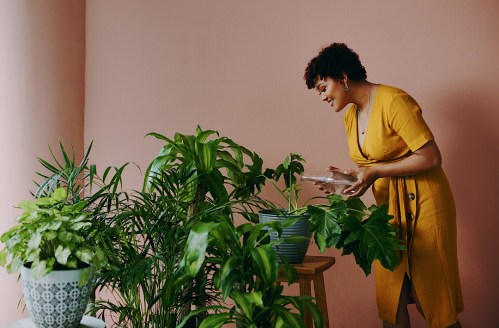Our editors independently select these products. Making a purchase through our links may earn Well+Good a commission
A Plant Pro’s 7 Best Tips To Keep Your Plants Alive When You’re on Vacation
While you’re away, use these tips for keeping plants alive on vacation from a plant pro to keep your indoor and outdoor plants happy at home.

Plant parents know that keeping plant babies thriving is no easy feat. They require a precise amount of water and light, and you need to adjust when the temps change. Plant parent duties get even trickier when you have a dramatic, high-maintenance houseplant. (We’re looking at you, fiddle-leaf fig). Another thorny task: keeping your plants alive on vacation.
Experts in This Article
gardening expert at Bloomscape
Since houseplants are accustomed to living in a controlled environment, Lindsay Pangborn, a gardening expert at Bloomscape, says the key to keeping them alive while you’re away is ensuring the plants experience the same conditions as they do when you’re home. Below, the plant pro shares her top tips for doing just that.
Keep the temperature the same
Before you hit the road, Pangborn recommends setting your thermostat to the same temperature you usually have it set when you’re home, if possible. “Any drastic change in temperature can seriously stress out your plant,” she says.
Leave your blinds open
In addition to making the temperature just right for your plant babies, you must also ensure they get the ideal amount of light while you’re gone. To do so, leave the blinds open to allow the plants to soak up all that natural light. Pangborn also advises adjusting the plant’s position, so they don’t receive too much light. “For plants that need a full amount of sunlight, move them away from windows by a few feet, allowing them to still receive bright light without using up their water supply as quickly,” she says.
If leaving the blinds open isn’t an option, Pangborn suggests investing in grow lights and timers that regulate light automatically.
Give plants a good soak before you leave
Pencil in some time to give your plants a really good soak to best prepare for your time away. “Water deeply by allowing water to soak into the soil until it flows out from the bottom of the pot,” Pangborn says. “Leave your plants to drain for about 20 minutes before placing them back on their saucers.” Pro tip: Move the plants to the bath or shower when you do this to avoid making a mess and ensure you dump any excess water out of the saucers to avoid causing root rot.
Create a humid environment
If you have plants in your collection that thrive on humidity and you typically have a humidifier running, there are some techniques for mimicking that environment. “Create a humid microclimate while away by grouping your plants together in a small room or space that receives natural daylight,” Pangborn says.
To create extra moisture in the air, you can also make a pebble tray. “Place a layer of pebbles in a tray and add water to the top of the pebbles. Then, set your plants on top,” Pangborn says. “As water evaporates from the tray, it increases the humidity in the air, and the pebbles prevent the pot from sitting directly in water.”
Place outdoor plants in the shade
Outdoors plants, too, will need some love while you’re on holiday. Like with indoor plants, Pangborn advises giving them a thorough soak before leaving and moving them to a shaded, protected area where they are out of direct sunlight. “Full sun and windy conditions will cause the planters to dry out much more quickly,” she says. “A week or two in the shade won’t harm the long–term health of those plants.”
Trim outdoor flowering plants
For outdoor planters with flowering plants, it’s also important to trim any flowers before you head out of town. “This will slow down the use of water, reduce the chance of fungal growth, and while you’re away, the plants will work on producing new flowers—meaning you’ll have a new batch of fresh blooms to enjoy when you return,” Pangborn says.
Invest in watering tools
For small indoor plants that require frequent watering, Pangborn recommends investing in watering tools such as capillary mats and watering bulbs, which you can snag at most gardening supply stores. Capillary mats are made out of cushiony, water-holding material. When plant pots are placed on top, the water is transferred from the mat into the soil.
Watering bulbs, Pangborn explains, are typically made of glass and have a large spherical chamber filled with water attached to a long, thin neck. “As the plant’s soil medium dries out, more water is allowed to drain from the chamber into the soil, keeping it consistently moist,” she says. The bigger the plant, the bigger watering bulb you’ll need.
Whether you use a capillary mat, a watering bulb, or other type of watering tool, Pangborn advises testing them out a few weeks before your trip to ensure your plants react well to them. With the help of these tools and all the above tips, your plant babies will be nourished for about two weeks. If you’re planning to be away longer than that, Pangborn says it’s best to ask a friend or family member to stop by and check in on your plants.
Oh hi! You look like someone who loves free workouts, discounts for cutting-edge wellness brands, and exclusive Well+Good content. Sign up for Well+, our online community of wellness insiders, and unlock your rewards instantly.
Sign Up for Our Daily Newsletter
Get all the latest in wellness, trends, food, fitness, beauty, and more delivered right to your inbox.
Got it, you've been added to our email list.








